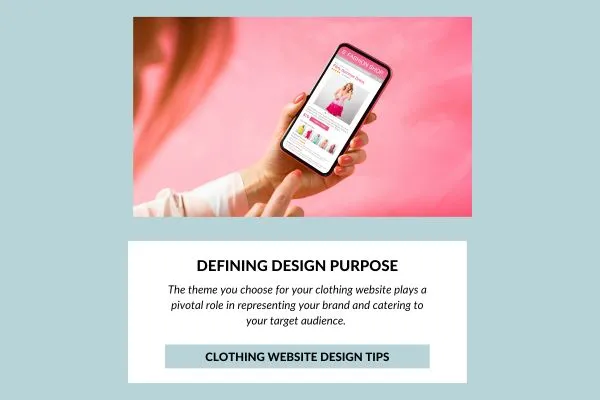When venturing into the world of e-commerce with a clothing website, the first crucial decision you’ll need to make before designing your clothing website is selecting the right theme and content management system (CMS). Your choice will significantly impact your clothing website’s success. So it’s very important to consider the various options available carefully.
I will share my ground clothing website designing experience. Let’s start.
Table of Contents
1. Defining Clothing Website Design Purpose
The theme you choose for your clothing website plays a pivotal role in representing your brand and catering to your target audience.

Before diving into the design process, determine the primary purpose of your website:
- Company Landing Page: If your clothing or fashion website is primarily a landing page for your clothing company, your design should reflect your brand’s identity and values.
- B2B Business Quote Clothing Site: In this case, the focus should be on providing a seamless and professional quoting experience for your business customers.
- B2C Shopping Site: For a clothing business-to-consumer shopping site, you’ll want to create an enticing and user-friendly platform that encourages online shoppers to make purchases.
Significance of the Theme
The first thing you do before designing a clothing website is select the website’s theme. Does the clothing website represent a company landing page, a B2B business quote clothing site, or a B2C shopping site? You have to decide it first.

The theme serves as the visual foundation of your clothing website. It sets the tone, communicates your brand’s identity, and directly influences the user experience.
2. CMS (Content Management System) Selection
Then, choose the medium of CMS for your website. There are a few options: WordPress, Wix, Shopify, or custom-made. If you are interested in custom-made design, then you have to hire a UX or UI designer to design the interface. Then, hire a web developer.
a. Readymade Options
Choosing the right CMS is a pivotal decision affecting how you create, manage, and update your fashion website. There are several popular options to consider:
- WordPress: Known for its user-friendliness and extensive theme library.
- Wix: A user-friendly, all-in-one website builder.
- Shopify: A dedicated e-commerce platform.
- Custom-Made: Tailored to your specific needs.
b. Custom-Made Design Considerations
When opting for a custom-made design for your clothing website, there are essential steps to consider.

This approach provides you with full control over your website’s design:
- The Need for UX/UI Designer: Hiring a UX (User Experience) and UI (User Interface) designer is essential to creating an intuitive and visually appealing website.
- Role of Web Developer: A skilled web developer will bring your design to life, ensuring it functions seamlessly.
c. Benefits of Each CMS Option
Each CMS option comes with its own set of advantages and disadvantages. Consider the specific needs of your clothing website to make an informed decision.
i. WordPress Features
WordPress is a highly popular CMS for clothing website design. It offers an array of advantages:
Template Options
- Free Theme: Access to a vast library of free templates for various styles.
- Paid Theme: Premium templates provide additional customization and features.
For fashion website designing experience, I can recommend a few themes: Generatepress, Neve, Astra with Gothenburg builder, and Elementor.
Flexibility in Design
WordPress allows you to import pre-designed templates or create a unique design inspired by your competitors, making it a versatile choice.
You can get hundreds of free and paid templates from where you can easily import the design or create a clothing website by inspiring from your competitor’s theme. You can use the one-click import option in most of the paid WordPress themes. It will allow you to save your time and money by customizing design from existing demos.
Hosting Choices
For WordPress, you can pick a regular web hosting; if you are targeting a local audience, then you should pick a local web hosting service. If you have an international mass audience, then you should pick dedicated VPS or cloud hosting.
When hosting your WordPress clothing website, consider your target audience:
- Regular Web Hosting: Suitable for a local audience.
- Local Web Hosting (for Targeting Local Audience): Ideal for businesses focused on a specific geographic region.
- Dedicated VPS or Cloud Hosting (for International Mass Audience): Recommended for websites with a global audience.
ii. Custom Website
You can create a custom website for your clothing website. If you are struggling with your budget and have a small business, then WordPress is best. But if you want a fully customized website that and withstand high traffic of more than 8-10 lakh for a month, then you should go with a custom website. You can choose NodeJs, Laravel, React, Javascript, and so on, website designing languages.
When to Choose a Custom Website
Deciding whether to opt for a custom website for your clothing business depends on various factors:
- Budget Considerations: If you have budget constraints, WordPress might be the best choice.
- Traffic Volume: For high-traffic websites, custom solutions like NodeJs, Laravel, React, or JavaScript become more relevant.
Matching Hosting Services
Select the hosting services that match the requirements of your custom website. Heavy websites typically benefit from VPS or cloud hosting facilities.
3. Key Considerations for Clothing Website Design
When it comes to clothing website design, success hinges on a well-thought-out approach that encompasses a wide range of key considerations.
Your clothing website should not only be visually appealing but also functional, user-friendly, and optimized for conversions. Let’s delve into these crucial factors:
A. User Experience

- Responsiveness and Mobile-Friendliness: In the age of smartphones, ensuring that your clothing website looks and functions flawlessly on mobile devices is paramount. Responsive design is key to providing a seamless experience across different screen sizes. Make sure the website is perfect for every device, from pc to mobile.
- Intuitive menu: A user-friendly navigation structure simplifies the browsing process. Organize your categories and pages logically, making it easy for visitors to find what they want.
- Page Load Speed: Slow-loading pages can drive potential customers away. Optimize images and utilize efficient coding to keep your website’s load times to a minimum. You can check your final website speed from Google’s page speed insight, GTmatrix, Pingdom speed tester, etc.
- Clear Calls to Action: Encourage users to take desired actions, whether making a purchase, signing up for a newsletter, or following your social media accounts. Well-placed and compelling calls to action can make all the difference.
B. Visual Appeal
- Attractive Color Schemes: Select colors that resonate with your brand and evoke the right emotions. Consistency in color schemes across your website helps create a memorable and cohesive visual identity.
- High-Quality Images and Graphics: In the clothing industry, visuals are everything. Use high-resolution images to showcase your products in the best possible light. Consider investing in professional photography to make a lasting impression.
- Consistent Branding: Your clothing website should reflect your brand’s identity. Maintain a consistent visual style, including logos, fonts, and design elements, to reinforce your brand’s image.
- Effective Use of White Space: White space, or negative space, is crucial for readability and visual balance. Avoid clutter and give your content room to breathe. It will enhance the overall user experience.
C. Product Presentation
- Clear Product Images: Your product images should be crystal clear, with multiple angles and views when applicable. Customers should be able to see every detail of your clothing items.
- Optimized Image Size: Bulk images could increase the website loading time. For this, you can convert all pictures into webp form rather than PNG format.
- Detailed Product Descriptions: Provide comprehensive and accurate descriptions for each product, such as sizing information, materials, care instructions, and any unique selling points. Besides, take care of fashion seo things such as alter text, captions, geo tags, etc.
- Filters and Search Functionality: Implement a robust filtering system to help users narrow their choices based on various criteria. A search bar with autocomplete can further enhance the shopping experience.
- Customer Reviews and Ratings: Include user-generated reviews and ratings to build trust and help customers make informed purchasing decisions. It will increase SEO strength to the search engine. Encourage satisfied customers to leave reviews.
D. E-commerce Functionality
- Easy Shopping Cart Management: Simplify the shopping cart experience with easy-to-understand icons and clear product summaries. Shoppers should easily add, remove, and update items.
- Secure Payment Options: Offer a variety of secure payment methods and prominently display trust indicators to assure customers of their financial safety, such as: Paypal, Visa, Master card, etc.
- Wishlist and Favorites Features: Allow customers to save items for future consideration. It will make it easier for them to return and complete their purchase.
- Inventory Management: Keep track of stock levels to prevent overselling and ensure accurate availability information on your shopping website.
E. Content and Information
- About Us Page: Craft a compelling “About Us” page that tells your brand’s story, mission, and values. Connect with your audience on a personal level.
- Contact Information: Make it simple for customers to ask questions or concerns. Provide multiple contact methods, including email, phone, and a contact form.
- Size Charts and Fit Guides: Offer detailed size charts and fit guides to assist customers in choosing the right size, reducing returns and exchanges.
- Blog and Fashion Tips: A well-maintained blog with fashion tips and insights can attract and engage your target audience while establishing your expertise in the clothing industry.
By paying close attention to these key considerations, you can create a clothing website that not only looks stunning but also functions smoothly and provides a top-notch user experience. Remember that continuous monitoring and improvement are essential for long-term success in the competitive world of online clothing sales.
Conclusion
In conclusion, the process of clothing website design begins with the critical decisions of theme and CMS selection. Carefully consider the purpose of your website and the specific needs of your clothing business to make informed choices. Your design choices should align with your budget and business goals, ensuring a successful online presence for your clothing brand.
I tried to cover all these things from my clothing website designing experience. Fashion Website I have designed:
- Ximena valero– A Shopify Clothing Store.
- Custom LA Manufacturer – WordPress landing page.
- Raimentpark-bd – Buying House Website Design [Based on Elementor – WordPress].
- Fashion SEO Agency – A fashion agency website – Based on WordPress.
- Textile Trainer – A textile blog site.
If you would like to contact me for clothing website design at an affordable cost, please contact me.
